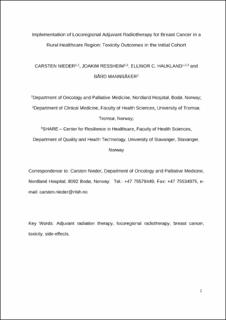| dc.contributor.author | Nieder, Carsten | |
| dc.contributor.author | Ressheim, Joakim Grønning | |
| dc.contributor.author | Haukland, Ellinor Christin | |
| dc.contributor.author | Mannsåker, Bård | |
| dc.date.accessioned | 2023-03-16T11:33:02Z | |
| dc.date.available | 2023-03-16T11:33:02Z | |
| dc.date.created | 2022-05-19T14:31:01Z | |
| dc.date.issued | 2022 | |
| dc.identifier.citation | Nieder, C., Ressheim, J., Haukland, E. C., & Mannsåker, B. (2022). Implementation of Locoregional Adjuvant Radiotherapy for Breast Cancer in a Rural Healthcare Region: Toxicity Outcomes in the Initial Cohort. Anticancer Research, 42(2), 923-928. | en_US |
| dc.identifier.issn | 0250-7005 | |
| dc.identifier.uri | https://hdl.handle.net/11250/3058733 | |
| dc.description.abstract | Background/Aim: The aim of this study was to analyze the toxicity of locoregional adjuvant breast cancer radiotherapy after implementation of this service in a rural healthcare region with long travel distance. Patients and Methods: This was a retrospective single-institution analysis of 87 consecutive female patients (the initial cohort), managed with conventionally fractionated 3-D conformal radiotherapy with or without boost, including both post mastectomy and breast conservation scenarios. Treatment was administered in line with comprehensive national guidelines. Intensity-modulated techniques were not utilized. Results: The median follow-up time was 4 years. None of the patients developed any grade IV side-effects. According to Radiation Therapy Oncology Group criteria, acute grade 2b or 3 skin toxicity was observed in 16%. In addition, 35% developed acute grade 2a skin reactions. A trend was observed regarding grade 2-3 skin toxicities and administration of a boost (p=0.058). There was a significant association between the clinical target volume of the breast and grade 2-3 skin reactions in women who had breast-conserving surgery (p=0.016). Five patients (6%) developed grade 1 pneumonitis, unrelated to dosimetric or other baseline parameters. Conclusion: The toxicity profile after a median follow-up of 4 years was in accordance with published data. Recently, intensity-modulated techniques have been implemented at the study center, which may reduce radiotherapy toxicity in patients with large clinical target volume due to better dose homogeneity. | en_US |
| dc.language.iso | eng | en_US |
| dc.publisher | International Institute of Anticancer Research | en_US |
| dc.title | Implementation of Locoregional Adjuvant Radiotherapy for Breast Cancer in a Rural Healthcare Region: Toxicity Outcomes in the Initial Cohort | en_US |
| dc.title.alternative | Implementation of Locoregional Adjuvant Radiotherapy for Breast Cancer in a Rural Healthcare Region: Toxicity Outcomes in the Initial Cohort | en_US |
| dc.type | Peer reviewed | en_US |
| dc.type | Journal article | en_US |
| dc.description.version | acceptedVersion | en_US |
| dc.rights.holder | The owners/authors | en_US |
| dc.subject.nsi | VDP::Medisinske Fag: 700 | en_US |
| dc.source.pagenumber | 923-928 | en_US |
| dc.source.volume | 42 | en_US |
| dc.source.journal | Anticancer Research | en_US |
| dc.source.issue | 2 | en_US |
| dc.identifier.doi | 10.21873/anticanres.15551 | |
| dc.identifier.cristin | 2025715 | |
| dc.relation.project | SHARE - Centre for Resilience in Healthcare: 5091 | en_US |
| cristin.ispublished | true | |
| cristin.fulltext | postprint | |
| cristin.qualitycode | 1 | |
